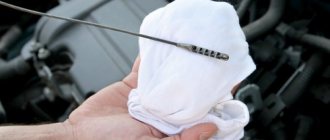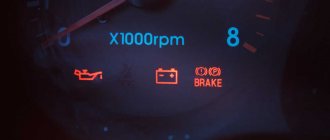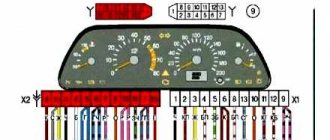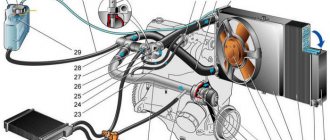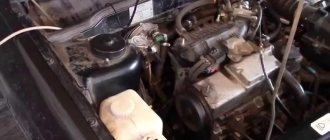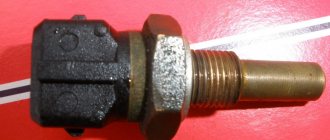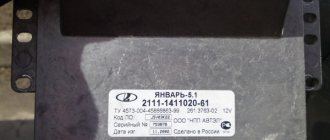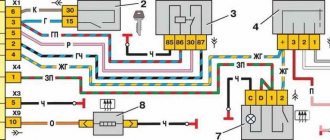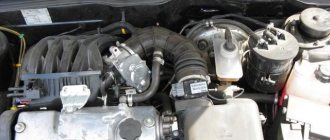The bane of every driver is the check engine warning light. Who has never peered with bated breath at this dashboard light when starting the car (will it go out or continue to burn)? Who has managed to avoid encountering such an “alarm signal” even once during the entire operation of the car? Almost no one. This is because there are a lot of reasons for the ECU, or more precisely the ECM (electronic engine control system), to be “concerned” about the serviceability of the power plant and related components. Both serious and trivial. Let us immediately make a reservation that there are additional factors of urgency in solving a potential problem, such as:
- combination with other warnings;
- indicator flashing;
- (relevant on some cars in cases where further driving may be dangerous) the check engine light turns red;
- The general “behavior” of transport is cause for concern.
The range of possible errors is truly enormous, so let’s look at the most common ones. So, the check engine light comes on, what should you do?
The car owner's reaction to the indicator's operation
It is worth immediately understanding that the light of the check does not always indicate some kind of malfunction.
How to recognize a problem signal:
- If it flashes when you start the engine and immediately stops, everything is fine, just check the operating parameters.
- If it lights up and does not go out for a long time or lights up constantly, there is something wrong with the engine. But the reason may not be serious, so you shouldn’t panic right away. Of course, a critical breakdown cannot be ruled out either.
If the check engine light comes on: 5 most common reasons for the “Check engine” light to turn on
Many of us have encountered such a problem as turning on the engine icon (Check engine...), the appearance of which frightens car drivers. We offer you the 5 most common reasons why the check engine light comes on on the dashboard.
The engine warning light usually appears without warning. The reason for the appearance of the Check engine cannot be immediately understood. Even if the car has auto diagnostics (for example, in cars such as BMW, Audi, Porshe, Mercedes-Benz, VW), which scans all car systems for errors and, if any, displays a decryption on the information panel, the reasons for the check engine light will not be decrypted .
For most drivers, the appearance of this warning icon on the dashboard means the need to urgently go to a car repair shop to diagnose and eliminate the reason why the “Check Engine” warning sign appeared. But in fact, in most cases, when the “Check” indication appears, you can independently diagnose the cause of the engine failure and, in some cases, possibly eliminate the cause yourself without a trip to a car service center, which will save you money.
Why is a warning system needed?
Why the Lada Granta check engine light is on and what to do
A panel that flashes periodically or is constantly on, which depicts an engine outline, or has the inscription “Check Engine” can be translated as “check the engine.” Its appearance warns the driver about emerging problems in the power unit. Most of all, its appearance worries novice drivers, but there is no need to be afraid, you just need to diagnose the engine and then eliminate the identified faults. The first such blocks were connected to an on-board computer; its main purpose was to control the carburetor of the power unit.
Cars are constantly improving, and so are electronic control units. Now they control other systems, such as ignition, supply, formation of a combustible mixture, engine speed, and other parameters. As a result of this modernization, the reasons for the control unit to react have become many times greater, so it has become much more difficult to understand the reasons for the appearance of warning signals, and sometimes it is completely impossible to do without special equipment
Lambda probe
It is mistakenly called an oxygen sensor, although it has nothing to do with oxygen. The lambda probe is designed to capture unburned fuel residues that are formed when the ignition timing is incorrect. Thanks to the data received from the sensor, the angle is adjusted, as well as the saturation of the mixture with gasoline.
In the absence of information caused by a malfunction of the lambda probe, ECU, or, as it is also called, the controller switches the power plant to emergency operation. In this mode, the mixture is supplied as if it were a carburetor - in strictly specified proportions in order to maintain engine performance until it arrives at the service center. Accordingly, a check light lights up on the instrument panel, which indicates a malfunction.
The main signs of sensor failure are:
- Increased fuel consumption;
- “Floating” speed;
- Increased harmful emissions from the exhaust pipe;
Catalyst
The catalyst is an important component of a modern car. It is an exhaust gas “filter” that traps unburned fuel residues. Inside it there are honeycombs coated with titanium, which have a very small cross-section. When exhaust gases pass, carbon monoxide settles on the honeycombs and the output is a gas that causes less harm to the environment.
It is quite natural that sooner or later the catalyst becomes clogged and has a lower throughput.
The car loses power because it spends energy on removing exhaust gases and the sensor gives too high readings regarding the amount of unburned fuel.
It all ends with the engine going into emergency mode and the check light coming on. The problem can only be solved by replacing the faulty element.
The catalyst lasts quite a long time, but there are factors that have a fairly significant influence on this process. One of them is poor fuel quality. To avoid this, try to refuel only at trusted gas stations. Only then can his life be extended.
Reasons why the check engine light is on
Let's not go far and turn to the simplest and easily removable defects. A typical situation - you refueled at a gas station, turned the ignition key, drove off... and a characteristic icon “shines” on the dashboard. If the car does not make noise or jerk, you should return to the gas station to check the following points:
- the fuel tank cap is open/the system is not sealed;
- drop in oil level (check the quantity and quality with a dipstick, and also look for leaks);
- the fuel pump is acting up;
- the injectors are clogged;
- ignition coils are damaged;
- spark plugs are sooted or out of order;
- the cylinder does not produce a spark;
- problems with the oxygen sensor (lambda probe);
- the catalyst is broken;
- low quality fuel.
If the check engine light is on, make an appointment for an internal combustion engine diagnostic.
Vehicle malfunction at idle
If the VAZ 2114 power unit idles at idle, then:
In the first case, the fuel system is flushed and the injectors are cleaned. To carry out the last work, ultrasound is used. In the second case, you will need to replace the spark plugs, high-voltage wires, and diagnose the ignition coils. In the latter case, the valves are replaced or readjusted.
If the power unit stalls while running hot, then auto mechanics advise carrying out similar work as described above. At idle speed with a heated engine, one cylinder may not work due to malfunctions in the fuel mixture supply system or lack of spark. In this case, it is recommended to carry out the same work as in case of failures during cold running.
Before you begin independent repair work, you need to find out what tripling of the power unit is. This concept means the operation of the engine without the participation of one of the cylinders. If such a process is accompanied by a blinking check, then the lambda probe, fuel tank filler cap, catalyst, air mass flow sensor are checked. The motor indicator icon appears without warning, so it is impossible to immediately find out the reason for the blinking check. Before repairing a VAZ, the electrical circuit and design features of the vehicle are studied.
If you lack experience and knowledge in the field of electromechanics, it is recommended to seek help from a specialized service.
Replace the oxygen sensor (lambda probe)
The oxygen sensor in your car is part of the exhaust system that monitors how much oxygen is not burned in the engine's combustion chamber. This sensor helps control the vehicle's fuel consumption. A malfunctioning oxygen sensor (lambda probe) means that the car computer is receiving incorrect data, which can significantly increase fuel consumption and reduce engine power. Most cars have 2 to 4 oxygen sensors. If you have a home car error scanner, then by connecting it to the car, you can easily find out which sensor needs to be replaced.
For what reason does the oxygen sensor in a car become unusable: Over time, the sensor becomes covered with a layer of used engine oil (oil soot), which reduces the accuracy of reading sensor readings for regulating the gasoline mixture and distributing optimal fuel consumption. A malfunction of the oxygen sensor in a car leads not only to increased fuel consumption, but also to an increased content of harmful CO2 substances in the exhaust.
What needs to be done: If you do not change a faulty car oxygen sensor, this can lead to failure of your car's catalyst (it may burst), which will result in expensive repairs. The cost of new catalysts is very high due to the precious alloys they contain. On some cars, there are several catalysts, the cost of which can reach up to 90,000 rubles. So don't delay replacing the sensor. Although replacing the sensor and its cost is not very small, it is not commensurate with the cost of the exhaust gas catalyst system. You can also save on replacement costs by doing it yourself. Many car manuals have detailed instructions on how to replace the oxygen sensor yourself. If you know where the oxygen sensor is located, then it will not be difficult for you to disconnect the faulty lambda probe and replace it with a new one. Remember that you cannot delay replacing this important element!
What does the check engine light mean?
The name of the Check engine indicator literally translates as “Check engine”. However, when the light comes on or blinks, the engine may have absolutely nothing to do with it. A lit indicator may indicate problems in the fuel supply system, failure of individual ignition elements, etc.
Sometimes it can be a very minor problem - for example, a loose gas cap or a faulty catalyst. However, you should not ignore the indicator signals under any circumstances, as this can result in serious problems.
The Check indicator may light up for various reasons.
Sometimes the cause of the indicator light may be poor fuel quality. So don’t be surprised if, after refueling at an unfamiliar gas station, you see the Check Engine light flashing.
Typically the indicator is located on the car's dashboard under the engine speed indicator. It is indicated by a schematic engine or a rectangle with the inscription Check engine or simply Check. In some cases, instead of an inscription, a lightning symbol is depicted.
The check engine light is on on the VAZ-2114 and is working normally, what should I do?
The dashboard on the car provides the driver with information about the speed of travel, the distance traveled, data on the use of light and sound alarms (headlights, turn signals), as well as engine operation. Moreover, the latter uses the most information sensors and warning lamps. As cars improve, the number of these lamps only increases. Nowadays, almost all cars have a warning sensor called “Check engine”. People have already nicknamed him “Jackie Chan”, or simply “Check”. It is often represented on the dashboard as a stylistic representation of the engine and glows orange.
Check-Engine icon on the dashboard
Check engine is a diagnostic warning sensor. It's simple: modern cars are equipped with electronic control units that control a number of car systems. The electronic control unit (ECU) is the brain of the machine. At the same time, there are a large number of installed sensors that signal the operation of automotive systems. And if any of them transmits information to the ECU about a malfunction of the system, then the control unit signals this on the panel by lighting up the “Check”.
With a normally functioning power unit, this signal should light up only during startup, after which it should immediately go out. But if this warning light stays on for more than half an hour, this indicates problems in the operation of one of the engine systems.
Let us immediately note that the ECU does not control the operation of all mechanisms and systems, but only a number of them. However, their number may vary due to the design features of the car itself. On the first cars where the “Check” signal began to be installed, its lighting indicated problems only with the operation of the carburetor and that’s all. But later his “sphere of influence” increased significantly.
On modern cars, the lighting of this lamp may mean that the system is malfunctioning:
In general, any system that uses performance monitoring sensors can cause the check engine light to come on. In addition to the fact that the ECU sends a signal to turn on the lamp, it also enters an error code into its memory, which indicates which of the sensors failed.
All this is aimed at ensuring that the problem in the operation of the motor can be quickly identified and eliminated. But to read this code for decoding, you need a scanner, which not all drivers have. It’s good if the car is equipped with a function to display an error code on the on-board computer display, then it’s easier to understand which system is failing. But not all cars have such a function.
Video: Injector. The check engine light is on.
https://youtu.be/5D6Ddu7g4m4
Therefore, we will try to figure out what to do and where to look for the reason for the lighting of this warning light. Let’s say right away that the “Check” does not always indicate serious problems with the motor; sometimes it triggers for petty reasons, which can even be classified as false positives. But you shouldn’t ignore this signal either. It is better to immediately try to find the reason for the glowing “Check”.
Other warning lights on the dash can help narrow your search. Thus, the lubrication and cooling systems often have their own “controls”. And if one of them lights up together with the “Check”, then you can immediately understand which of the systems has failed.
The situation is worse with other car systems, primarily with power and ignition. The operation of the engine directly depends on them, but there are no additional “controls” on the dashboard from these systems, which means it will be more difficult to identify the cause.
Video: What does Check Engine mean and why can it light up?
The main reasons why the Check engine light comes on
Below we will consider the most common reasons for the “Check” to light up on the dashboard, as well as what should be done and how to eliminate it. We will consider the reasons for each system separately. Note that the ECU data comes from different sensors, but the main one for turning on the “Check engine” is the lambda probe. This means that the operation of the “Check” primarily concerns systems that provide the supply of mixture components and its combustion, that is, power and ignition.
First, let's figure out how to understand whether a malfunction has actually occurred and intervention is required, or whether it was just a false positive. For example, it may occur when contact with one of the sensors is lost (due to oxides or vibration), but then everything is restored, while the “Check” may continue to light up, since information about the non-working sensor has already been entered into the computer’s memory.
The test is very simple - just remove the terminal from the battery for a couple of minutes and connect it again. As a result, the data will be reset, including the error message, and the “Check Engine” will go out.
If there was a false alarm, the lamp should go out and not turn on again. But if after some time it lights up again, you should look for the cause. At the same time, you should not “abuse” data reset. After all, a “Check” is only a consequence of problems occurring, so disconnecting the battery only allows you to turn off the glowing lamp, and this will not solve the breakdown itself.
Supply system
Video: HOW TO REMOVE (CLEAR, ELIMINATE) “CHECK” on a car?
So, we made a reset, but after a while the “Check” caught fire again. This indicates that the alarm is not false and it’s time to get under the hood. Most often, the reason for the lamp to work is the power supply system.
It can catch fire due to:
- poor fuel quality;
- interruptions in the operation of the fuel pump;
- incorrect operation of injectors;
Interestingly, the cause of a sensor fire is often a loose tank cap. This reason can be attributed to false positives. And everything happens because a certain pressure must be maintained in the tank so that the gas pump can work fully. A tightly screwed cap creates a slight vacuum.
If the cap is not tightened enough, air will flow into the tank freely, causing the pump to supply more fuel to the system (it will be easier for it to pump it). And although not all the fuel gets into the cylinders, what does get in will lead to an enrichment of the mixture and, as a result, a change in the composition of the exhaust gases. And the lambda umbrella will react to this. The result will be the ignition of the “Check”.
Poor quality gasoline also has such consequences. That is, impurities in the fuel affect the composition of the exhaust gases, which is the reason for the “control” to light up.
In the first case, it is enough to simply check the tank cap. If you are not confident in the quality of gasoline, then it is better to replace it with a known good one, then drive it a little, and then reset it. If the lamp does not light up afterwards, the cause has been eliminated.
Fuel pump malfunctions can also cause this. It can also include a filter element. If the pump does not provide the required pressure, this immediately affects the combustible mixture (it is lean), and the lambda probe will detect this. To check, you will have to check the performance of the pump, as well as the throughput of the filter. If they do not meet the standard, they are changed, after which the data is reset.
Clogged injectors will not be able to spray fuel efficiently, and the amount of fuel supplied will decrease. The problem is eliminated by simply washing the injectors.
Ignition system
Not only the fuel system can affect the composition of the exhaust gases, the ignition system can also do this. The “check” may light up due to:
- Non-working spark plug
- All candles as a result of their resource exhaustion
- Breakdown of high-voltage wires
- Ignition coil failures
All this leads to disruption of the combustion process in the cylinders, which ensures a violation of the composition of the exhaust gases. If one of the spark plugs on the engine does not work, the “Check” will definitely light up.
All spark plugs have a service life, after which the quality of the spark discharge deteriorates. In this case, the fuel will no longer be able to burn properly. Therefore, when a lamp lights up, first of all, the spark plugs are checked, and then the high-voltage wires going to them (if any). Then the condition of the ignition coil(s) is diagnosed.
exhaust system
As you can see, the main reason for the “Check” to light up is the readings of the lambda probe. But at the same time, this sensor itself may be the cause of the “glowing motor” on the dashboard. Often a large layer of carbon deposits forms on this sensor, which affects its operation. Therefore, it is imperative to check the lambda probe for functionality.
The second element of the exhaust system that can cause problems is the catalytic converter (if equipped). If this element is heavily clogged and does not perform its functions, this will affect the readings of the lambda probe. In this case, the catalyst is replaced (which is very expensive), or a flame arrester is installed instead.
Please note that the article contains only the most common causes of the Check Engine light. But there are much more of them, and this depends on the design features of the car itself. The same wiring, or rather its violation, can cause the warning light to light up.
Therefore, it is better not to hope that a false alarm has occurred, but to immediately contact specialists to resolve the problems. You can also purchase a scanner and identify the cause yourself.
Materials: https://avtomotoprof.ru/obsluzhivanie-i-uhod-za-avtomobilem/chto-delat-esli-zagorelsya-check-engine/
Why did the light come on and how to fix it
https://www.youtube.com/watch?v=YFZdPKaDzkA
The main situations in which the indicator lights up and the recommended courses of action for the car owner:
- If the Check engine lights up and goes out immediately when starting the car, there is no damage to the engine. The cause of the fire is most likely harmless - the fuel tank cap is lost or not screwed in properly. Just wrap it tightly and check if the warning disappears.
- If the indicator lights up while driving, you should stop and check the wires. You may find a cable hanging loose under the hood or an open battery terminal. This applies to all attachments - wires, hoses, etc.
- If the light flashes while driving, you should stop and check the sounds made by the engine, pay attention to the oil level, and inspect the sides of the engine. If no visually obvious violations are detected, it is recommended to drive to the nearest car service center and carry out diagnostics.
- If the engine is running normally and the Check light is constantly flashing, there is most likely an ignition failure. You should check the spark plugs and coil, pay attention to the quality of the fuel. To do this, it is better to contact the nearest auto diagnostic center.
- If the indicator is constantly on, you need to stop, unscrew the spark plugs and check the gap. Gaps that exceed 1.3 may cause the light bulb to burn out.
- In addition, when the “check” is on, the ignition is usually checked. Any car service center has special testers that allow you to determine the wear of wiring insulation.
- A faulty fuel pump can also cause the light to come on. You should stop and listen to the sounds the fuel pump makes. A smooth hum without clicks or pauses is considered normal. If extraneous sounds appear, the pump should be dismantled, washed inside and the filter cleaned.
- Serious engine malfunctions can be indicated by the coolant temperature. If it is above 85–90 degrees, and the Check engine lights up while driving, the engine is definitely faulty. In this case, it is advisable to call a tow truck or drive at low speed to the nearest car service center.
We have already noted that the Check light comes on every time you start the engine in yellow or orange. This is normal if the flashing lasts no more than 3-4 seconds and stops when the other dashboard lights flash. Otherwise, follow the steps recommended above.
In most cases, as the table shows, Check lights up when a sensor fails or the operating conditions of the vehicle change. However, even after diagnosing and eliminating the malfunction, the light sometimes continues to light.
The fact is that the “trace” of the error remains in the computer’s memory. In this case, you should “reset” or “zero” the indicator readings. You can easily do this yourself by performing a number of simple operations:
- Turn off the ignition.
- Open the hood.
- Disconnect the positive terminal from the battery.
Resetting or resetting the Check Engine Light - After one minute, reinstall the terminal.
- Close the hood and turn on the ignition.
The sensor is reset and the Check light is no longer on. If this does not happen, contact the service center.
When the Check Engine light comes on on the dashboard, you almost always need to stop the car immediately. Using the recommendations given in this article in practice will help you avoid complex, expensive engine repairs. Good luck on the roads!
Mass fuel flow sensor
Mass air flow sensor is a very important element of any injection engine. It is a plastic structure with a platinum thread inside. When the ignition is turned on, a small voltage is applied to it, which increases the temperature due to the high resistance. When the engine starts, the incoming air cools it, which causes the resistance to change, and according to Ohm's law, this affects the voltage. All this data is collected by the controller and processed, making a conclusion about how much air passes through the mass air flow sensor.
If the sensor malfunctions, important readings stop coming or are given in an incorrect form, which is why the engine control unit switches it to emergency mode. In addition, there are a number of signs that indicate a malfunction:
- Poor dynamics;
- Long engine start;
- Increased fuel consumption;
- Unstable or “floating” speed;
Communication with cars
As with most problems with personal transport, you need to be able to listen to it. Modern vehicles are equipped with “brains” and interactive dashboards to “talk” to you, but it’s also wise to pay attention to the “classical language”: knocks, vibrations, hums, loss of power and much more. We looked at the most “popular” answers to the question why the check engine light is on. We hope this helps. Good luck on the roads! In any incomprehensible situation, go to the online platform for selecting car services Uremont.com to leave a request for service or consult a master consultant for free by ordering a call.
